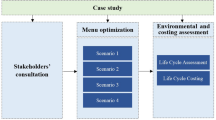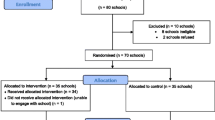Abstract
Purpose
This work analyses the meal supply in primary schools in Italy to highlight new areas of inefficiency upstream of the food chain, regarding the size of the food portions specified in public tenders. A lack of conformity of food portions can potentially lead to a double negative externality affecting the sustainability of school meals: overweight children and food waste.
Method
Based on the data contained in the contract between municipalities and school catering services, the analysis was performed on the portion sizes (in grams) of the main food products included in the school menu for each regional capital (RC) in Italy. Data analysis regarded two main aspects: consistency of food portions within regions and adherence to national standards for childrens.
Results
The results revealed great discrepancies amongst regions and in several cases, portion sizes significantly larger than the reference values of standard portions for school catering. The study also profiles RC on the basis of portion sizes, school meal attendance, and childhood obesity rates.
Conclusions
School meals have the potential to educate the next generation regarding healthy eating habits, and thus play a leading role in obesity prevention in children. Similarly, the educational role of eating at school can contribute to raising children’s awareness about one of the most urgent environmental challenges—food waste—by introducing the best strategies for waste reduction, reuse, and recycling. Results have economic, social, health, and environmental implications and highlight the need to revisit policies to introduce new solutions for more sustainable and healthy school canteens in Italy.
Level of evidence
Level V, descriptive studies.



Similar content being viewed by others
References
Italian Ministry of Health (2010) National Guidelines for school catering services. http://www.salute.gov.it/imgs/C_17_pubblicazioni_1248_allegato.pdf
Società Italiana di Nutrizione Umana, (SINU) (2014) IV Revisione dei Livelli di Assunzione di Riferimento di Nutrienti ed energia per la popolazione italiana (LARN). http://www.sinu.it/html/pag/tabelle_larn_2014_rev.asp
Andreis ML (2013) Dossier ristorazione scolastica – Vizi e virtù del mercato. Ristorando. http://www.markas.com/fileadmin/user_upload/Markas%20International/Dokumente/01.10.2013_Ristorando_Vizi_e_virt%f9_del_mercato.pdf
Liquori T (2006) Rome, Italy: a model in public food procurement: what Can the United States Learn. New York: liquori and associates. http://www.baumforum.org/downloads_conference-presentations/sf06/rome_briefing.pdf
Ministero dell’Ambiente e della Tutela del territorio e del Mare (2018) I criteri Ambientali Minimi. http://www.minambiente.it/pagina/i-criteri-ambientali-minimi
World Health Organization (2016) The challenge of obesity- quick statistics. http://www.euro.who.int/en/health-topics/noncommunicable-diseases/obesity/data-and-statistics
National Institute of Health (ISS) (2016) Okkio alla salute. http://www.epicentro.iss.it/okkioallasalute/dati2016.asp
Lombardo FL, Spinelli A, Lazzeri G, Lamberti A, Mazzarella G, Nardone P, Caroli M (2015) Severe obesity prevalence in 8-to 9-year-old Italian children: a large population-based study. Eur J Clin Nutr 69(5):603. https://doi.org/10.1038/ejcn.2014.188
Natale R, Chang C, Messiah S (2016) Obesity Prevention in Young Children. Obesity. https://doi.org/10.1016/j.cct.2016.12.011
Adab P, Pallan MJ, Lancashire ER, Hemming K, Frew E, Barrett T, Daley A (2018) Effectiveness of a childhood obesity prevention programme delivered through schools, targeting 6 and 7 year olds: cluster randomised controlled trial (WAVES study). BMJ 360:k211. https://doi.org/10.1136/bmj.k211
Ermetici F, Zelaschi RF, Briganti S, Dozio E, Gaeta M, Ambrogi F, Morricone L (2016) Association between a school-based intervention and adiposity outcomes in adolescents: the Italian “EAT” project. Obesity 24(3):687–695. https://doi.org/10.1002/oby.21365
Laureati M, Bergamaschi V, Pagliarini E (2014) School-based intervention with children. Peer-modeling, reward and repeated exposure reduce food neophobia and increase liking of fruits and vegetables. Appetite 83:26–32. https://doi.org/10.1016/j.appet.2014.07.031
Waters E, Gibbs L, Tadic M, Ukoumunne OC, Magarey A, Okely AD, Johnson B (2018) Cluster randomised trial of a school-community child health promotion and obesity prevention intervention: findings from the evaluation of fun ‘n healthy in Moreland! BMC Public Health 18(1):92. https://doi.org/10.1186/s12889-017-4625-9
Lloyd J, Creanor S, Logan S, Green C, Dean SG, Hillsdon M, Ryan E (2018) Effectiveness of the Healthy Lifestyles Programme (HeLP) to prevent obesity in UK primary-school children: a cluster randomised controlled trial. Lancet Child Adoles Health 2(1):35–45. https://doi.org/10.1016/S2352-4642(17)30151-7
Belot M, James J (2011) Healthy school meals and educational outcomes. J Health Econ 30(3):489–504. https://doi.org/10.1016/j.jhealeco.2011.02.003
Pomeranz JL, Miller DP (2015) Policies to promote healthy portion sizes for children. Appetite 88:50–58. https://doi.org/10.1016/j.appet.2014.12.003
Fisher JO, Liu Y, Birch LL, Rolls BJ (2007) Effects of portion size and energy density on young children’s intake at a meal. Am J Clin Nutr 86(1):174–179. https://doi.org/10.1093/ajcn/86.1.174
Syrad H, Llewellyn CH, Johnson L, Boniface D, Jebb SA, Van Jaarsveld CH, Wardle J (2016) Meal size is a critical driver of weight gain in early childhood. Sci Rep 6:28368. https://doi.org/10.1038/srep28368
Östergren K, Gustavsson J, Bos-Brouwers H, Timmermans T, Hansen OJ, Møller H, Easteal S (2014) FUSIONS definitional framework for food waste. http://www.europarl.europa.eu/sides/getDoc.do?pubRef= //EP//TEXT + REPORT + A8-2017-0175 + 0 + DOC + XML + V0//EN
European U (2008) Directive 2008/98/EC of the European Parliament and the Council of 19 November 2008 on Waste and Repealing Certain Directives. Official Journal of the European Union, 22/11/2008
Papargyropoulou E, Lozano R, Steinberger JK, Wright N, Bin Ujang Z (2014) The food waste hierarchy as a framework for the management of food surplus and food waste. J Clean Prod 76:106–115. https://doi.org/10.1016/j.jclepro.2014.04.020
Mena C, Adenso-Diaz B, Yurt O (2011) The causes of food waste in the supplier–retailer interface: Evidences from the UK and Spain. Resour Conserv Recycl 55(6):648–658. https://doi.org/10.1016/j.resconrec.2010.09.006
Aschemann-Witzel J, De Hooge I, Amani P, Bech-Larsen T, Oostindjer M (2015) Consumer-related food waste: causes and potential for action. Sustainability 7(6):6457–6477. https://doi.org/10.3390/su7066457
Neff RA, Kanter R, Vandevijvere S (2015) Reducing food loss and waste while improving the public’s health. Health Aff 34(11):1821–1829. https://doi.org/10.1377/hlthaff.2015.0647
Byker CJ, Farris AR, Marcenelle M, Davis GC, Serrano EL (2014) Food waste in a school nutrition program after implementation of new lunch program guidelines. J Nutr Educ Behav 46(5):406–411. https://doi.org/10.1016/j.jneb.2014.03.009
Welker E, Lott M, Story M (2016) The school food environment and obesity prevention: progress over the last decade. Curr Obes Rep 5(2):145–155. https://doi.org/10.1007/s13679-016-0204-0
Payán DD, Sloane DC, Illum J, Farris T, Lewis LB (2017) Perceived Barriers and Facilitators to Healthy Eating and School Lunch Meals among Adolescents: A Qualitative Study. Am J Health Behav 41(5):661–669. https://doi.org/10.5993/AJHB.41.5.15
Dinis D, Martins ML, Rocha A (2013) Plate waste as an indicator of portions inadequacy at school lunch. Int Sch Sci Res Innov 7:477–480
Ishdorj A, Capps O Jr, Storey M, Murano PS (2015) Investigating the relationship between food pairings and plate waste from elementary school lunches. Food Nut Sci 6(11):1029. https://doi.org/10.4236/fns.2015.611107
ADEME (2016) Réduire le gaspillage alimentaire en restauration collective. Guide pratique. ADEME edition. http://www.ademe.fr/sites/default/files/assets/documents/reduire_le_gaspillage_alimentaire_en_restauration_collective_010256.pdf
Waste and Resources Action Programme (WRAP) (2011) Food Waste in Schools. Summary report. Wrap publishing. http://www.wrap.org.uk/sites/files/wrap/Food%20Waste%20in%20Schools%20Summary%20Report.pdf
Falasconi L, Vittuari M, Politano A, Segrè A (2015) Food waste in school catering: An Italian case study. Sustainability 7(11):14745–14760. https://doi.org/10.3390/su71114745
Boschini M, Falasconi L, Giordano C, Alboni F (2018) Food waste in school canteens: a reference methodology for large-scale studies. J Clean Prod 182:1024–1032. https://doi.org/10.1016/j.jclepro.2018.02.040
Langley J, Yoxall A, Heppell G, Rodriguez EM, Bradbury S, Lewis R, Rowson (2010) Food for Thought?—a UK pilot study testing a methodology for compositional domestic food waste analysis. Waste Manag Res 28(3):220–227. https://doi.org/10.1177/0734242X08095348
Angelo ACM, Saraiva AB, Clímaco JCN, Infante CE, Valle R (2017) Life cycle assessment and multi-criteria decision analysis: Selection of a strategy for domestic food waste management in Rio de Janeiro. J Clean Prod 143:744–756. https://doi.org/10.1016/j.jclepro.2016.12.049
Hebrok M, Boks C (2017) Household food waste: drivers and potential intervention points for design–an extensive review. J Clean Prod 151:380–392. https://doi.org/10.1016/j.jclepro.2017.03.069
Freedman MR, Brochado C (2010) Reducing portion size reduces food intake and plate waste. Obesity 18(9):1864–1866. https://doi.org/10.1038/oby.2009.480
Berkowitz S, Marquart L, Mykerezi E, Degeneffe D, Reicks M (2016) Reduced-portion entrées in a worksite and restaurant setting: impact on food consumption and waste. Public Health Nutr 19(16):3048–3054. https://doi.org/10.1017/S1368980016001348
MacQueen J (1967) Some methods for classification and analysis of multivariate observations. In: Proceedings of the fifth Berkeley symposium on mathematical statistics and probability, vol 1, No. 14. University of California Press, Berkeley, pp 281–297
Save the Children (2017) (Non) tutti a mensa. https://www.savethechildren.it/cosa-facciamo/pubblicazioni/non-tutti-mensa-2017
Bracale R, Milani L, Ferrara E, Balzaretti C, Valerio A, Russo V, Carruba MO (2013) Childhood obesity, overweight and underweight: a study in primary schools in Milan. Eat Weight Disord 18(2):183–191. https://doi.org/10.1007/s40519-013-0036-9
Bracale R, Marin LEM, Russo V, Zavarrone E, Ferrara E, Balzaretti C, Carruba MO (2015) Family lifestyle and childhood obesity in an urban city of Northern Italy. Eat Weight Disord 20(3):363–370. https://doi.org/10.1007/s40519-015-0179-y
Aknowledgements
The authors would like to thank the Dr. Lino Volpe (President of Elior Italia).
Author information
Authors and Affiliations
Corresponding author
Ethics declarations
Conflict of interest
The authors declare that they have no conflicts of interest.
Ethical approval
This article does not contain any studies with human participants or animals performed by any of the authors.
Informed consent
For this type of study formal consent is not required.
Appendix 1
Appendix 1
See Table 4.
Rights and permissions
About this article
Cite this article
Balzaretti, C.M., Ventura, V., Ratti, S. et al. Improving the overall sustainability of the school meal chain: the role of portion sizes. Eat Weight Disord 25, 107–116 (2020). https://doi.org/10.1007/s40519-018-0524-z
Received:
Accepted:
Published:
Issue Date:
DOI: https://doi.org/10.1007/s40519-018-0524-z




